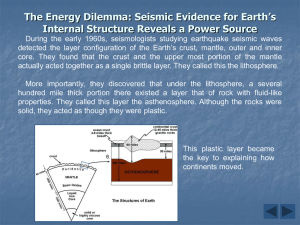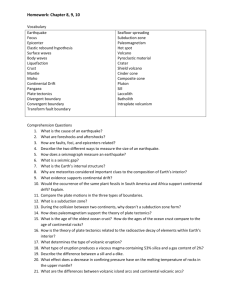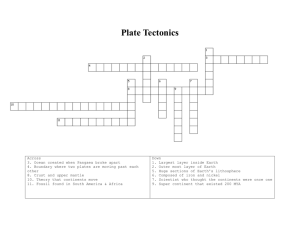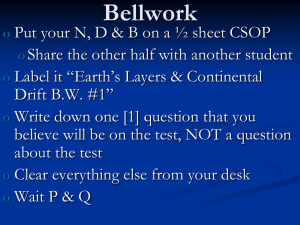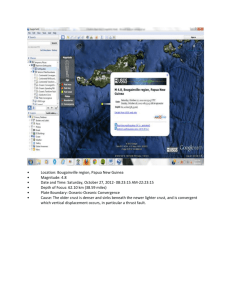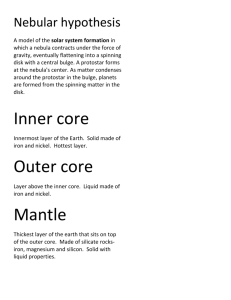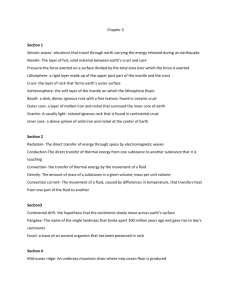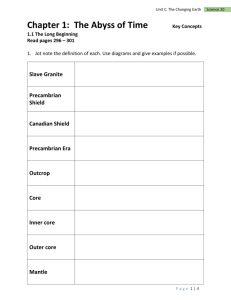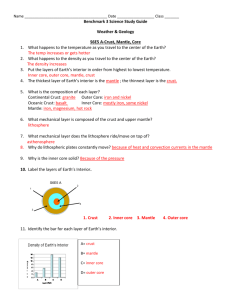ics fall 2012 midterm
advertisement
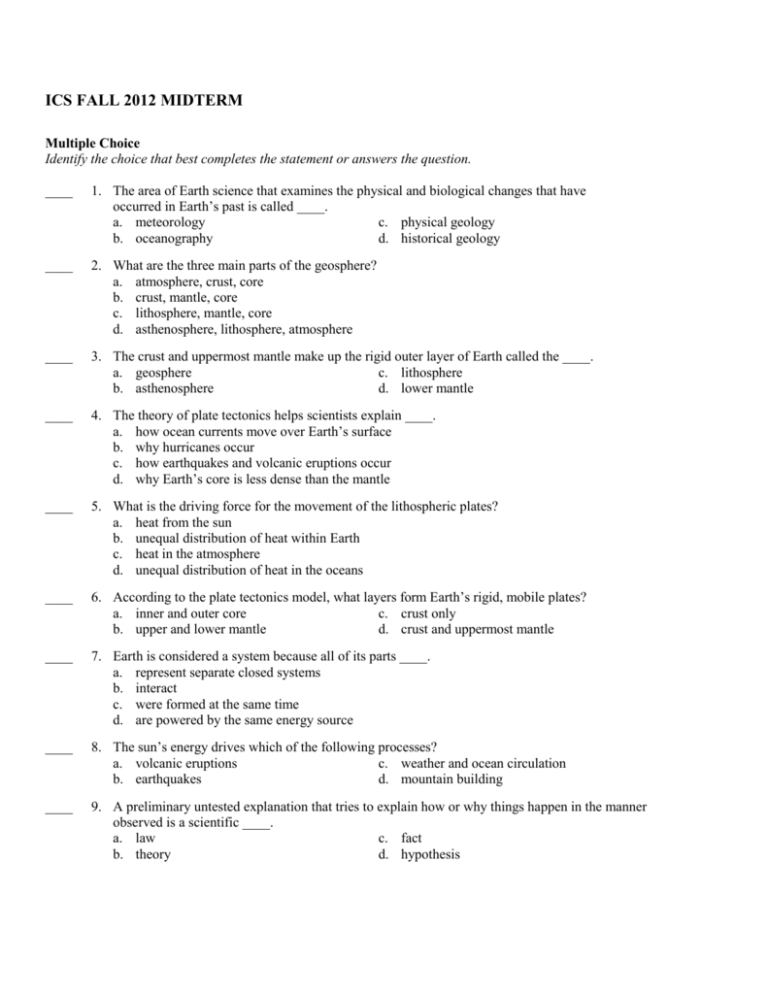
ICS FALL 2012 MIDTERM Multiple Choice Identify the choice that best completes the statement or answers the question. ____ 1. The area of Earth science that examines the physical and biological changes that have occurred in Earth’s past is called ____. a. meteorology c. physical geology b. oceanography d. historical geology ____ 2. What are the three main parts of the geosphere? a. atmosphere, crust, core b. crust, mantle, core c. lithosphere, mantle, core d. asthenosphere, lithosphere, atmosphere ____ 3. The crust and uppermost mantle make up the rigid outer layer of Earth called the ____. a. geosphere c. lithosphere b. asthenosphere d. lower mantle ____ 4. The theory of plate tectonics helps scientists explain ____. a. how ocean currents move over Earth’s surface b. why hurricanes occur c. how earthquakes and volcanic eruptions occur d. why Earth’s core is less dense than the mantle ____ 5. What is the driving force for the movement of the lithospheric plates? a. heat from the sun b. unequal distribution of heat within Earth c. heat in the atmosphere d. unequal distribution of heat in the oceans ____ 6. According to the plate tectonics model, what layers form Earth’s rigid, mobile plates? a. inner and outer core c. crust only b. upper and lower mantle d. crust and uppermost mantle ____ 7. Earth is considered a system because all of its parts ____. a. represent separate closed systems b. interact c. were formed at the same time d. are powered by the same energy source ____ 8. The sun’s energy drives which of the following processes? a. volcanic eruptions c. weather and ocean circulation b. earthquakes d. mountain building ____ 9. A preliminary untested explanation that tries to explain how or why things happen in the manner observed is a scientific ____. a. law c. fact b. theory d. hypothesis ____ 10. A scientific idea that is well tested and widely accepted by the scientific community is called a scientific ____. a. hypothesis c. theory b. inquiry d. method ____ 11. In scientific inquiry, when competing hypotheses have been eliminated, a hypothesis may be elevated to the status of a scientific ____. a. estimate c. theory b. idea d. truth ____ 12. A fault is ____. a. a place on Earth where earthquakes cannot occur b. a fracture in the Earth where movement has occurred c. the place on Earth’s surface where structures move during an earthquake d. another name for an earthquake ____ 13. Which of the following causes earthquakes? a. elastic rebound b. Richter scale c. release of heat d. frictional heating ____ 14. During an earthquake, the ground surface ____. a. moves only in a horizontal direction b. moves only in a vertical direction c. can move in any direction d. does not move ____ 15. Major earthquakes are sometimes preceded by smaller earthquakes called ____. a. aftershocks c. surface waves b. focus shocks d. foreshocks ____ 16. Which of the following is NOT a characteristic of S waves? a. They travel more slowly than P waves. b. They temporarily change the volume of material by compression and expansion. c. They shake particles at right angles to the direction the waves travel. d. They cannot be transmitted through water or air. ____ 17. What is the minimum number of seismic stations that is needed to determine the location of an earthquake’s epicenter? a. two c. four b. one d. three ____ 18. The trace that records an earthquake from seismic instruments is called a ____. a. seismograph c. richtergram b. seismogram d. magnitude ____ 19. Which of the following areas would most likely be the safest during a major earthquake? a. area with granite bedrock b. area with loosely consolidated soil c. area with structures built on a landfill d. area with steep slopes of unconsolidated sediments ____ 20. A building that settles unevenly after an earthquake is evidence of ____. a. a tsunami c. an underwater landslide b. liquefaction d. fault creep ____ 21. What layer of Earth is labeled C in Figure 8-2? a. the crust c. the mantle b. the asthenosphere d. the lithosphere ____ 22. Earth’s core is made of an alloy of ____. a. iron and nickel b. copper and iron c. zinc and magnesium d. iron and zinc ____ 23. Evidence about ancient climates indicates that ____. a. glacial ice once covered much of what is now India and Australia b. continents in the Northern Hemisphere today were once centered over the South Pole c. continents in the Southern Hemisphere today were once centered over the North Pole d. no continents occupied the Southern Hemisphere ____ 24. Wegener’s idea that tidal forces might cause continental drift was shown to be impossible when it was ____. a. determined that Earth’s magnetic field was too strong b. shown that the tidal forces needed to move continents would stop Earth’s rotation c. determined that Earth’s density was too low d. shown that no tides occurred 200 million years ago ____ 25. Which of the following statements correctly describes the asthenosphere? a. It is a thin, cold, and rigid layer. b. It is the source of Earth’s heat. c. It permits plate motion. d. It occurs only near subduction zones. ____ 26. A divergent boundary at two oceanic plates can result in a ____. a. rift valley c. continental volcanic arc b. volcanic island arc d. subduction zone ____ 27. What type of boundary occurs where two plates move together, causing one plate to descend into the mantle beneath the other plate? a. transform fault boundary c. convergent boundary b. divergent boundary d. transitional boundary ____ 28. Which of the following is a geographic example of a transform fault boundary? a. the East African Rift valley c. the Mid-Atlantic Ridge b. the San Andreas Fault d. the Andes Mountains ____ 29. New ocean crust is formed at ____. a. divergent boundaries b. convergent boundaries c. continental volcanic arcs d. transform fault boundaries ____ 30. Which of the following results when divergence occurs between two oceanic plates? a. seafloor spreading c. an ocean trench b. a subduction zone d. a volcanic island arc ____ 31. An example of a divergent plate boundary on continental lithosphere would be ____. a. the Mid-Atlantic Ridge c. the East African Rift Valley b. East Pacific Rise d. the Andes Mountains ____ 32. What feature is labeled B in Figure 9-1? a. trench b. ocean ridge c. volcanic island arc d. continental volcanic arc ____ 33. What process is illustrated by the area labeled G in Figure 9-1? a. seafloor spreading c. rifting b. continental volcanism d. subduction ____ 34. Which of the following does NOT occur at a subduction zone? a. The leading edges of both plates are bent upward. b. Oceanic crust is pushed down into the mantle. c. A continental plate moves over an oceanic plate. d. One oceanic plate moves beneath another oceanic plate. ____ 35. Oceanic lithosphere is destroyed at ____. a. transform fault boundaries b. divergent boundaries c. ocean ridges d. convergent boundaries ____ 36. Why are subduction zones not commonly found at convergent continental-continental boundaries? a. Continental lithosphere is too buoyant to be forced down into the mantle. b. Subduction zones are never found at convergent boundaries. c. Oceanic lithosphere is too buoyant to be forced down into the mantle. d. Continental lithosphere is too dense to be forced down into the mantle. ____ 37. What feature is labeled A in Figure 9-2? a. subduction zone b. trench c. volcanic island arc d. continental volcanic arc ____ 38. According to whole-mantle convection, ____. a. small amounts of material from the lower mantle move upward to the surface b. slabs of cold oceanic lithosphere move down and into the lower mantle c. large chunks of continental crust are pulled down into the lower mantle d. material from the inner core rises into the mantle to form super hot plumes ____ 39. As heat and pressure increase, ductile deformation ____. a. stops occurring c. becomes more likely b. becomes less likely d. is replaced by elastic deformation ____ 40. A material that undergoes tensional stress tends to ____. a. shorten c. become distorted b. stretch d. become less dense
